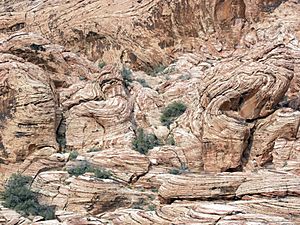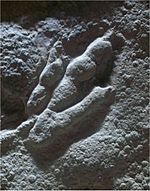Aztec Sandstone facts for kids
Quick facts for kids Aztec SandstoneStratigraphic range: Early Jurassic |
|
|---|---|

Outcrop of the Aztec Sandstone at Red Rock Canyon National Conservation Area near Las Vegas, Nevada
|
|
| Type | Sedimentary |
| Underlies | Willow Tank Formation |
| Overlies | Chinle Formation |
| Area | Nevada, Arizona, California |
| Thickness | 2,100 ft (640 m) in Goodsprings quadrangle 2,500 ft (760 m) in Muddy Mountain area |
| Lithology | |
| Primary | sandstone |
| Other | arenite, sand |
| Location | |
| Coordinates | 35°24′N 115°30′W / 35.4°N 115.5°W |
| Approximate paleocoordinates | 20°48′N 53°24′W / 20.8°N 53.4°W |
| Region | Mojave Desert |
| Country | |
| Type section | |
| Named by | D. F. Hewett |
| Year defined | 1931 |
The Aztec Sandstone is a special type of rock found in the Mojave Desert. It formed during the Early Jurassic period, which was about 174 to 201 million years ago. This rock is mostly made from ancient sand dunes that were blown by the wind.
Scientists have found amazing trace fossils in the Aztec Sandstone. These are not the bones of animals, but rather signs they left behind, like pterosaur footprints! You can find this rock formation in parts of Arizona, California, and Nevada.
Contents
What is the Aztec Sandstone?
The Aztec Sandstone is made of two main parts, or units. Each unit has different features.
Lower Unit: Strong and Colorful
The bottom part of the Aztec Sandstone is very strong. It is about 100 meters (328 feet) thick. When you see it outside, it looks tan or off-white. But if you see a fresh break in the rock, it can look pinkish.
You can easily spot cross-bedded lenses in this part. These are layers of sand that show how the wind blew the sand around a long, long time ago. The sand grains are mostly quartz. They look "frosted" and "pitted," like tiny glass beads that have been sandblasted. These grains are stuck together very tightly by a natural glue called silica.
Upper Unit: Softer and Layered
The top part of the Aztec Sandstone is not as strong as the lower unit. It is thicker, about 200 meters (656 feet). This unit has layers of white quartz arenite (a type of sandstone) mixed with red to brown sandy layers that contain more silt.
Ancient Animal Tracks
The Aztec Sandstone is famous for the ichnofossils found there. Ichnofossils are also called trace fossils. They are not the actual bodies of animals, but rather clues they left behind. Think of them as ancient footprints, burrows, or other marks.
These trace fossils help scientists learn about the animals that lived in the Early Jurassic period. They show us what kinds of creatures walked or moved across these ancient sand dunes.
Types of Trace Fossils Found
Here are some of the interesting trace fossils discovered in the Aztec Sandstone:
| Trace Fossils of the Aztec Sandstone | ||||||
|---|---|---|---|---|---|---|
| Genus | Species | Location | Member | Abundance | Notes | Images |
| Anchisauripus | These tracks were later identified as Grallator tracks. | |||||
| Brasilichnium | ||||||
| Grallator | ||||||
| Navahopus | ||||||
| Octopodichnus | ||||||
| Pteraichnus | These are tracks made by pterosaurs, ancient flying reptiles. | |||||
| Skolithos | These are fossilized burrows, not footprints. | |||||
Color key
|
Notes Uncertain or tentative taxa are in small text; |



